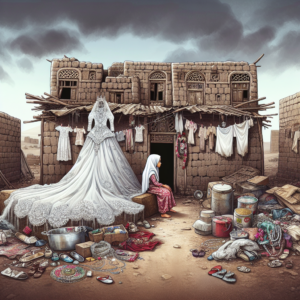Examining the Prevalence of Child Marriage: Causes, Consequences, and Solutions
Child marriage, a deeply rooted practice in many societies around the world, continues to affect millions of girls globally. It refers to the marriage of individuals below the age of 18 years, and it is considered a human rights violation by international conventions and laws. Despite efforts to eradicate this harmful practice, child marriage remains prevalent in many countries, posing severe consequences for the well-being and development of young girls. This article aims to explore the causes, consequences, and potential solutions to address the issue of child marriage.
Causes of Child Marriage:
There are numerous factors that contribute to the prevalence of child marriage, and they often vary across regions and communities. Some of the key causes include:
1. Traditional and cultural norms: In certain cultures, child marriage is deeply ingrained as a tradition or custom. Families may consider it a way to preserve societal norms, honor, or protect their daughters’ safety. These beliefs often reinforce the practice and make it challenging to change.
2. Poverty and economic factors: Economic constraints play a significant role in perpetuating child marriage. Families in impoverished areas may see marrying off their daughters at an early age as a way to reduce the financial burden on their households. The dowry system prevalent in some societies also contributes to child marriage, as families view it as an opportunity to receive financial assistance.
3. Gender inequality: Gender discrimination and the devaluation of girls continue to be significant contributors to child marriage. Deep-rooted patriarchal systems that prioritize sons over daughters limit girls’ access to education and economic opportunities. Consequently, families may view marriage as the only viable option for their daughters.
4. Lack of education: Limited access to education, particularly for girls, is a common factor in child marriage. When educational opportunities are scarce or deemed unnecessary for girls, families often resort to early marriage as an alternative.
Consequences of Child Marriage:
Child marriage has severe and long-lasting consequences for the lives of girls affected by it. These consequences encompass various aspects of physical, psychological, and social well-being. Some of the key consequences include:
1. Health risks: Early marriage exposes girls to higher risks of maternal and child mortality, as their bodies may not be fully developed for pregnancy and childbirth. Complications during childbirth are more prevalent among young mothers, posing life-threatening risks. Additionally, girls married at a young age face a higher likelihood of experiencing domestic violence, sexual abuse, and sexually transmitted infections.
2. Limited educational opportunities: Child marriage disrupts girls’ educational aspirations, as they are often forced to drop out of school to fulfill marital duties. The denial of education hampers their personal development, limits their future earning potential, and perpetuates the cycle of poverty.
3. Social isolation and mental health issues: Many girls who are married early face social isolation from their peers and community. This isolation, coupled with the burden of marital responsibilities, often leads to mental health issues such as anxiety, depression, and low self-esteem.
4. Generational impact: Child marriage perpetuates a cycle of poverty, illiteracy, and poor health outcomes. The children of young mothers are more likely to be malnourished, have limited access to education, and face a higher risk of mortality due to the intergenerational effects of child marriage.
Solutions to Address Child Marriage:
Addressing child marriage requires a holistic and multi-faceted approach that addresses its underlying causes and provides support for affected girls and their communities. Some potential solutions include:
1. Legislation and policy changes: Governments must enforce and strengthen legislation that sets a minimum age for marriage, ensuring its compliance across communities and regions. This may involve raising awareness about the legal consequences of child marriage and promoting the importance of birth registration.
2. Access to education: Bridging the gender gap in education is crucial to combating child marriage effectively. Policies should focus on providing equal access to quality education for girls, including measures such as scholarships, incentives, and school infrastructure improvements.
3. Community engagement and empowerment: Engaging communities in dialogue and raising awareness about the harms of child marriage can be instrumental in shifting social norms. Promoting gender equality, empowering girls with knowledge and skills, and involving influential community members can help challenge deeply ingrained practices.
4. Health services and support: Access to reproductive health services, including family planning and maternal healthcare, is critical for empowering girls and young women. Providing comprehensive sexual education and ensuring access to healthcare can help address the health risks associated with early pregnancies.
FAQs:
Q: How prevalent is child marriage globally?
A: According to UNICEF, an estimated 12 million girls are married before the age of 18 every year, resulting in around 1 in 5 women globally experiencing child marriage.
Q: Which regions are most affected by child marriage?
A: Child marriage is prevalent across different regions, including South Asia, Sub-Saharan Africa, the Middle East, and parts of Latin America and the Caribbean.
Q: What are some successful interventions to combat child marriage?
A: Successful interventions include community-driven initiatives that address underlying causes, such as education and economic empowerment programs for girls, community awareness campaigns, and legal reforms.
Q: What are the long-term benefits of ending child marriage?
A: Ending child marriage would lead to improved gender equality, better health outcomes for girls and their children, increased educational opportunities, and economic empowerment for women, contributing to sustainable development.
Q: How can individuals support efforts to end child marriage?
A: Individuals can raise awareness about child marriage, support organizations working on this issue, advocate for policy changes, and engage in dialogue within their communities to challenge harmful traditions and norms.
In conclusion, child marriage remains a significant global issue, with far-reaching consequences for the well-being and development of girls. Understanding the causes, recognizing the consequences, and implementing comprehensive solutions are essential steps towards eradicating this harmful practice. With concerted efforts from governments, communities, and individuals, we can create a future where every girl is free to thrive and fulfill her potential.






















